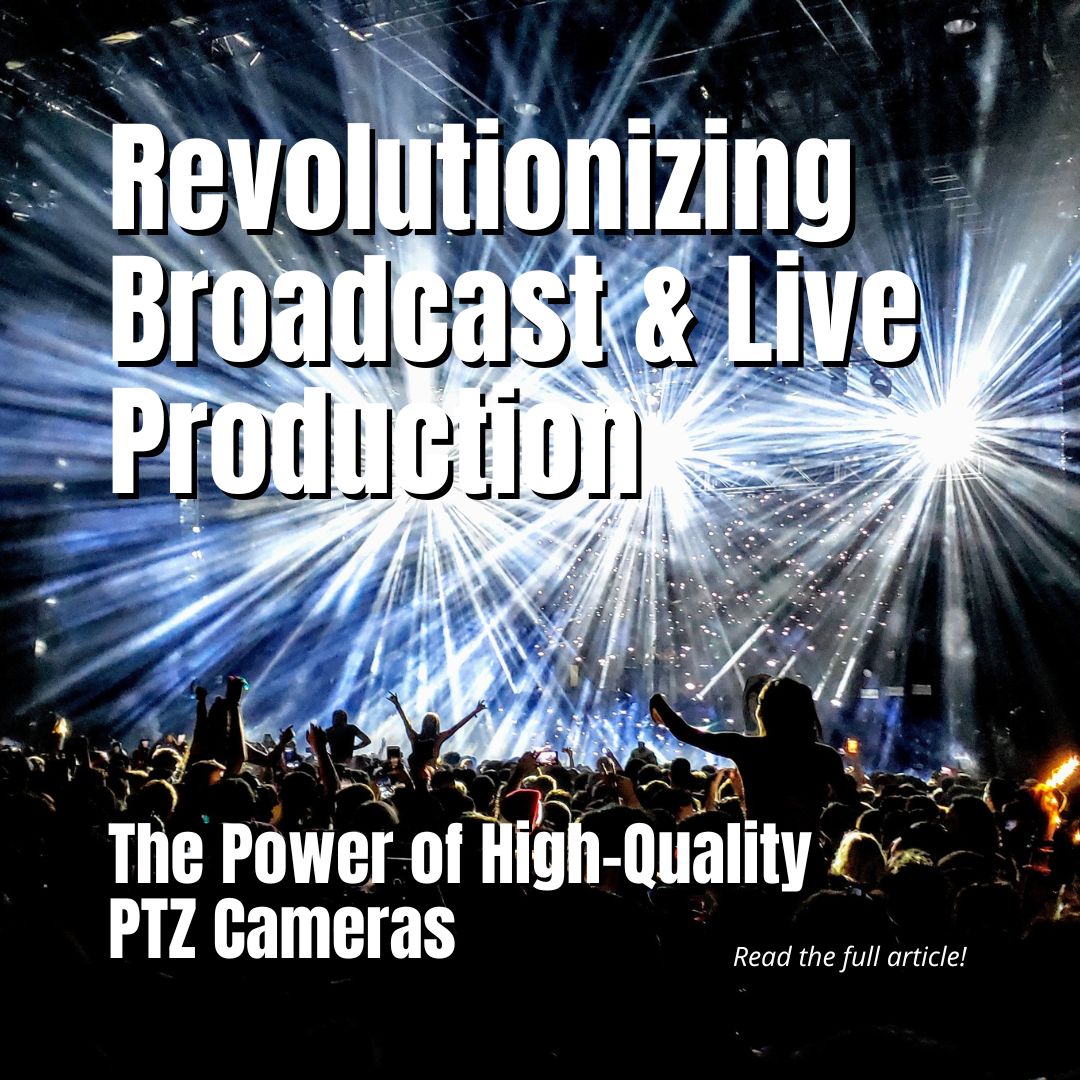The broadcast and live production industries are constantly evolving, with a persistent demand for better, more efficient, and higher-quality solutions. One such technological advancement is the integration of high-quality PTZ (Pan-Tilt-Zoom) cameras into various aspects of the industry, from television production to live streaming and event coverage. This article delves into the technology behind these improved PTZ cameras, their real-world applications, and how they are revolutionizing the broadcast and live production landscape.
PTZ Camera Technology: A Deeper Dive
PTZ cameras have been a mainstay in the broadcasting industry, but recent advancements have significantly improved their capabilities. Let’s take a closer look at the components and features of modern high-quality PTZ cameras:
High-Definition Sensors and Optics
Today’s PTZ cameras come equipped with cutting-edge, high-definition sensors and optics that offer excellent video quality. These cameras are capable of resolutions up to 4K UHD, providing crystal-clear images and impeccable detail, even in challenging lighting conditions. The use of advanced optics ensures minimal distortion and aberration, while large image sensors allow for excellent low-light performance and a wide dynamic range.
High-Precision Motors and Mechanics
One of the most crucial components of a PTZ camera is its motor and mechanical system, responsible for the camera’s movement and control. Modern PTZ cameras employ high-precision motors, offering smooth and accurate panning, tilting, and zooming capabilities. Additionally, these cameras provide ultra-quiet operation, making them suitable for use in noise-sensitive environments like live productions and on-set recordings.
Advanced Autofocus and Image Stabilization
High-quality PTZ cameras also come with sophisticated autofocus and image stabilization systems, ensuring that the captured video remains sharp and steady. Advanced algorithms and processing capabilities allow these cameras to quickly and accurately focus on subjects, even when they are moving or in low light. Image stabilization technology ensures that camera shake and vibration do not adversely impact the video quality, delivering stable footage in dynamic shooting scenarios.
Seamless Integration and Control
Modern PTZ cameras can be seamlessly integrated with existing broadcast and live production setups, thanks to their compatibility with industry-standard protocols and control systems. They can be easily controlled using hardware controllers, software applications, or even remotely via IP or serial connections. This level of integration and control allows for efficient operation and greater creative freedom in various production scenarios.
Real-World Applications of High-Quality PTZ Cameras
The versatility and advanced capabilities of high-quality PTZ cameras have made them invaluable tools in numerous real-world applications. Here are some of the most prominent use cases:
Television Production
PTZ cameras have gained popularity in various television production scenarios due to their versatility, ease of use, and cost-effectiveness. While not universally employed for all television productions, they are particularly well-suited for live broadcasts, news studios, talk shows, and sports events, where their remote control capabilities and smooth movement can be invaluable. PTZ cameras can be used to capture unique angles, provide quick transitions between different subjects or areas, and help create dynamic live shots with minimal effort. In addition, their easy integration into existing workflows makes them an attractive option for television production teams looking to optimize their operations and adapt to changing environments quickly.
Live Event Production and Streaming
High-quality PTZ cameras have become indispensable in live event production and streaming, as they offer the flexibility and reliability needed in these fast-paced environments. They can be used to cover multiple angles or positions, enabling directors to switch between different shots with ease. Furthermore, their silent operation and unobtrusive design make them perfect for capturing live performances, sports events, and conferences without disrupting the experience for attendees.
News and Sports Broadcasting
In news and sports broadcasting, PTZ cameras provide a cost-effective and efficient solution for capturing high-quality video. Their compact size and remote operation capabilities allow for easy deployment in various locations, such as studios, newsrooms, or on the sidelines of a sports event. This enables news and sports broadcasters to cover stories and events in real-time with minimal setup and crew requirements.
Additionally, the advanced autofocus and image stabilization features of high-quality PTZ cameras ensure that the footage remains sharp and steady, even during fast-paced action sequences or when capturing subjects from a distance. These cameras can be used for a wide range of applications, including live interviews, press conferences, and sideline reporting, offering broadcasters greater flexibility and creative control.
Remote Production and Virtual Sets
The remote operation capabilities of PTZ cameras have opened up new possibilities for remote production and virtual set environments. High-quality PTZ cameras can be controlled from a central location, eliminating the need for on-site camera operators and reducing travel and staffing costs. This allows production teams to cover multiple locations or events simultaneously, increasing efficiency and productivity.
Moreover, the integration of PTZ cameras into virtual set environments enables the creation of immersive and interactive experiences for viewers. With precise camera movements and seamless integration with virtual set technology, these cameras can be used to create dynamic and engaging content that would be difficult or impossible to achieve with traditional camera setups.
Education and Corporate Communications
High-quality PTZ cameras have also found a place in educational and corporate settings, where they are used for live streaming, video conferencing, and recording presentations or lectures. Their ease of use and integration with existing AV systems make them an ideal solution for these environments, providing professional-quality video without the need for complex setups or extensive training.
The advanced features of modern PTZ cameras, such as high-definition video, autofocus, and image stabilization, ensure that presentations and lectures are visually engaging and easy to follow. The ability to remotely control the camera’s pan, tilt, and zoom functions allows for dynamic presentations and discussions, enhancing the overall experience for both presenters and viewers.
Roles and Responsibilities in Operating PTZ Cameras
In the realms of television, live production, and streaming events, the responsibility for operating and managing PTZ cameras typically falls on different roles depending on the specific production scenario and team structure. In some cases, a dedicated camera operator might be responsible for operating the PTZ cameras, following the director’s guidance and the requirements of the production. In live production or broadcast environments, the Technical Director or Vision Mixer often assumes the responsibility for switching between different camera feeds, including PTZ cameras, and may also control the PTZ cameras’ movement and framing as needed, based on the director’s instructions. In smaller-scale productions with limited crew members, the director or producer might take on the responsibility of operating the PTZ cameras themselves. Close collaboration and communication between the team members are essential to ensure seamless operation and optimal results, ultimately leading to more engaging and innovative content.
The Impact of High-Quality PTZ Cameras on the Industry
The integration of high-quality PTZ cameras into various aspects of the broadcast, television, live production, and streaming production industries has had a profound impact on the way content is created and consumed. Here are some key areas where these cameras are making a difference:
Cost and Resource Efficiency
The use of PTZ cameras reduces the need for large production crews and extensive equipment setups, leading to significant cost savings and increased efficiency. This allows organizations to allocate resources more effectively and focus on other aspects of production or content creation.
Enhanced Creativity and Flexibility
The advanced features and capabilities of high-quality PTZ cameras offer greater creative control and flexibility for directors, producers, and camera operators in various production scenarios. The ability to capture dynamic and complex shots with ease opens up new possibilities for storytelling and visual impact, resulting in more engaging and innovative content, particularly in the realms of television, live production, and streaming events.
Improved Accessibility and Collaboration
The remote operation capabilities of PTZ cameras enable teams to collaborate and create content across multiple locations, breaking down geographical barriers and allowing for more diverse perspectives and ideas. This increased accessibility also extends to education and corporate settings, where PTZ cameras can facilitate more interactive and engaging learning experiences.
High-quality PTZ cameras have transformed the landscape of broadcast, television, live production, and streaming production, offering unparalleled video quality, advanced features, and seamless integration with existing workflows. As the technology continues to advance and evolve, these cameras are set to play an even more critical role in shaping the future of the industry. From revolutionizing live event coverage to enhancing remote production capabilities, high-quality PTZ cameras are at the forefront of innovation and are poised to drive further growth and success in the years to come.




